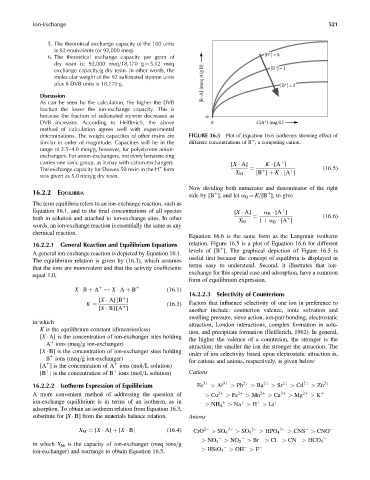Page 566 - Fundamentals of Water Treatment Unit Processes : Physical, Chemical, and Biological
P. 566
Ion-Exchange 521
5. The theoretical exchange capacity of the 100 units
is 92 equivalents (or 92,000 meq). +
6. The theoretical exchange capacity per gram of [B ]=0
dry resin is: 92,000 meq=18,170 g ¼ 5.12 meq +
exchange capacity=g dry resin. In other words, the [B ]=1
molecular weight of the 92 sulfonated styrene units
plus 8 DVB units is 18,170 g. [R A] (meq A/g R) [B ]=2
+
Discussion •
As can be seen by the calculation, the higher the DVB
fraction the lower the ion-exchange capacity. This is
because the fraction of sulfonated styrene decreases as 0
+
DVB increases. According to Helfferich, the above 0 C(A ) (mg/L)
method of calculation agrees well with experimental
determinations. The weight capacities of other resins are FIGURE 16.5 Plot of Equation 16.6 isotherms showing effect of
similar in order of magnitude. Capacities will be in the different concentrations of B , a competing cation.
þ
range of 2.5–4.0 meq=g, however, for polystyrene anion-
exchangers. For anion-exchangers, not every benzene ring
carries one ionic group, as it may with cation-exchangers. [X A] K [A ]
þ
The exchange capacity for Dowex 50 resin in the H form ¼ (16:5)
þ
þ
þ
X M [B ] þ K [A ]
was given as 5.0 meq=g dry resin.
Now dividing both numerator and denominator of the right
16.2.2 EQUILIBRIA
side by [B ], and let a B ¼ K=[B ], to give
þ
þ
The term equilibria refers to an ion-exchange reaction, such as
Equation 16.1, and to the final concentrations of all species [X A] a B [A ]
þ
both in solution and attached to ion-exchange sites. In other ¼ þ (16:6)
X M 1 þ a B [A ]
words, an ion-exchange reaction is essentially the same as any
chemical reaction.
Equation 16.6 is the same form as the Langmuir isotherm
16.2.2.1 General Reaction and Equilibrium Equations relation. Figure 16.5 is a plot of Equation 16.6 for different
levels of [B ]. The graphical depiction of Figure 16.5 is
þ
A general ion-exchange reaction is depicted by Equation 16.1.
useful first because the concept of equilibria is displayed in
The equilibrium relation is given by (16.3), which assumes
terms easy to understand. Second, it illustrates that ion-
that the ions are monovalent and that the activity coefficients
exchange for this special case and adsorption, have a common
equal 1.0,
form of equilibrium expression.
X B þ A $ X A þ B þ (16:1)
þ
16.2.2.3 Selectivity of Counterions
[X A] [B ]
þ
(16:3) Factors that influence selectivity of one ion in preference to
K ¼
[X B] [A ]
another include: counterion valence, ionic solvation and
þ
swelling pressure, sieve action, ion-pair bonding, electrostatic
in which
attraction, London interactions, complex formation in solu-
K is the equilibrium constant (dimensionless)
tion, and precipitate formation (Helfferich, 1962). In general,
[X A] is the concentration of ion-exchanger sites holding
the higher the valence of a counterion, the stronger is the
A ions (meq=g ion-exchanger)
þ
attraction; the smaller the ion the stronger the attraction. The
[X B] is the concentration of ion-exchanger sites holding
order of ion selectivity based upon electrostatic attraction is,
B ions (meq=g ion-exchanger)
þ
for cations and anions, respectively, is given below:
[A ] is the concentration of A ions (mol=L solution)
þ
þ
[B ] is the concentration of B ions (mol=L solution) Cations
þ
þ
16.2.2.2 Isotherm Expression of Equilibrium Fe 3þ > Al 3þ > Pb 2þ > Ba 2þ > Sr 2þ > Cd 2þ > Zn 2þ
A more convenient method of addressing the question of > Cu 2þ > Fe 2þ > Mn 2þ > Ca 2þ > Mg 2þ > K þ
ion-exchange equilibrium is in terms of an isotherm, as in
> NH 4 > Na > H > Li þ
þ
þ
þ
adsorption. To obtain an isotherm relation from Equation 16.3,
substitute for [X B] from the materials balance relation, Anions
X M ¼ [X A] þ [X B] (16:4) CrO 2 > SO 4 2 > SO 3 2 > HPO 4 3 > CNS > CNO
> NO 3 > NO 2 > Br > Cl > CN > HCO 3
in which X M is the capacity of ion-exchanger (meq ions=g
> HSiO 3 > OH > F
ion-exchanger) and rearrange to obtain Equation 16.5.

